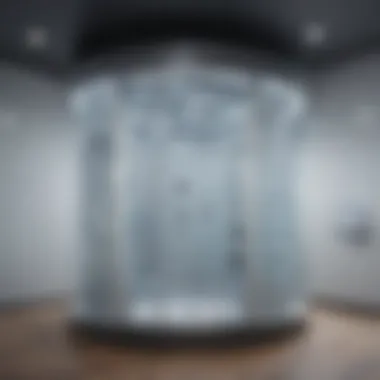Unlocking the Potential: Impact of Cryotherapy on Athletic Performance and Recovery


Strategies for Success
Leadership Psychology Insights
Within the realm of cryotherapy's influence on athletes, insights from leadership psychology play a pivotal role. Emotional intelligence in leadership becomes a key aspect as athletes navigate the expectations and pressures of their sport. Effective communication skills are crucial in conveying the importance of incorporating cryotherapy into training routines. Moreover, implementing team-building strategies that align with the collaborative nature of cryotherapy can foster a supportive environment for athletes to optimize their performance.
Personal Growth and Development
A comprehensive exploration of cryotherapy's impact on athletes extends to personal growth and development aspects. Encouraging mindset shifts for success could involve reframing how athletes perceive recovery and its role in their overall performance. Self-care practices that integrate cryotherapy as a rejuvenating tool can enhance an athlete's holistic well-being. Furthermore, strategies for overcoming challenges and adversities while integrating cryotherapy into training routines can cultivate resilience among athletes.
Business Growth Strategies
While focused on athletic performance, the application of cryotherapy parallels business growth strategies in various ways. Marketing and branding strategies within the context of cryotherapy's benefits can amplify its appeal to a wider athlete audience. In terms of financial management, understanding the investment in cryotherapy equipment and services necessitates a strategic approach to optimize returns. Exploring innovation and entrepreneurship through the lens of incorporating cryotherapy into athletic recovery regimens can open up new avenues for business advancement.
Case Studies and Real-Life Examples
To provide a tangible understanding of cryotherapy's impact on athletes, delving into case studies and real-life examples becomes imperative. Success stories of entrepreneurs who have leveraged cryotherapy within their training routines can inspire athletes to explore its potential benefits. Extracting leadership lessons from industry experts who advocate for cryotherapy usage sheds light on its efficacy in enhancing performance. Additionally, examining business turnaround case studies where cryotherapy played a role in revitalizing athletic programs underscores its transformative impact.
Introduction to Cryotherapy
In this article, we delve into the crucial concept of cryotherapy and its impact on athletes. Cryotherapy, a method embraced by many athletes to enhance their performance and recovery, holds significant value in the realm of sports medicine. Understanding the fundamentals of cryotherapy is essential for athletes aiming to optimize their training regimens and achieve peak physical condition. This section will unravel the various aspects of cryotherapy, shedding light on its benefits, risks, and scientific basis.
What is Cryotherapy?
Cryotherapy, at its core, involves the application of cold temperatures to the body for therapeutic purposes. By exposing the body to extremely low temperatures, often through specialized chambers or localized treatments, cryotherapy aims to trigger physiological responses that contribute to healing and rejuvenation. The utilization of cold for medicinal benefits has garnered attention in recent years, especially within the sports community, where athletes seek means to expedite recovery and promote overall well-being.
History of Cryotherapy
The roots of cryotherapy can be traced back centuries, with early civilizations recognizing the invigorating effects of cold exposure on the human body. From ancient practices like ice baths to modern cryochambers, the evolution of cryotherapy highlights a persistent interest in harnessing the power of cold for therapeutic gains. Over time, cryotherapy has transitioned from a niche treatment to a mainstream intervention embraced by athletes and health enthusiasts worldwide.


Types of Cryotherapy
Whole Body Cryotherapy
Whole Body Cryotherapy involves exposing the entire body to cold temperatures, typically ranging from -100°C to -140°C for a short duration. This form of cryotherapy is reputed for its ability to reduce inflammation, accelerate recovery, and enhance performance. Athletes often opt for whole-body treatments to reap the systemic benefits of cold exposure, promoting cellular repair and metabolic efficiency.
Localized Cryotherapy
Localized cryotherapy targets specific areas of the body, delivering concentrated cold therapy to localized injuries or sore muscles. By focusing cold treatment on particular regions, athletes can address isolated pain points and accelerate healing in targeted areas. This form of cryotherapy offers precision in targeting injuries without subjecting the entire body to extreme cold temperatures.
Ice Bath Therapy
Ice Bath Therapy, a traditional form of cryotherapy, involves immersing the body in ice-cold water to elicit a therapeutic response. Athletes frequently turn to ice baths post-exercise to reduce muscle soreness and inflammation. While ice baths remain a popular choice for recovery, advancements in cryotherapy technology have introduced more precise and controlled methods of cold exposure for athletes.
Benefits of Cryotherapy for Athletes
In the realm of athletic performance and recovery, cryotherapy stands out as a pivotal tool for enhancing overall well-being and efficiency. Athletes, whether professional or amateur, constantly push their physical limits, necessitating optimized strategies for recuperation and peak functionality. The benefits of cryotherapy in this context are multifaceted, extending beyond mere physical relief to encompass psychological rejuvenation and performance enhancement. Understanding the significance of cryotherapy for athletes is paramount in cultivating a competitive edge and sustaining long-term athletic prowess.
Enhanced Recovery
Enhanced recovery through cryotherapy plays a crucial role in the athlete's journey towards optimal performance. By subjecting the body to controlled cold temperatures, cryotherapy triggers physiological responses that accelerate the healing process post-exertion. This accelerated recovery is essential for athletes looking to minimize downtime between training sessions or competitions. Cryotherapy helps reduce muscle soreness, inflammation, and fatigue by promoting vasoconstriction and increasing blood circulation. As a result, athletes experience quicker recovery times, allowing them to maintain peak performance levels consistently.
Pain Management
Pain management is a central concern for athletes grappling with the rigors of intensive training and physical exertion. Cryotherapy emerges as a non-invasive and effective method for alleviating muscular and joint pain commonly experienced in the realm of sports. By targeting specific areas of discomfort through local cryotherapy or whole-body cryotherapy sessions, athletes can experience significant pain relief. The cold temperatures applied during cryotherapy sessions numb nerve endings, reduce inflammation, and improve joint function, offering athletes a natural and holistic approach to pain management without relying on pharmacological agents.
Inflammation Reduction
Inflammation poses a considerable challenge to athletes, hindering performance and impeding recovery. Cryotherapy's ability to reduce inflammation serves as a valuable asset to athletes seeking to mitigate the impact of strenuous physical activity on their bodies. Cold therapy techniques employed in cryotherapy help constrict blood vessels and decrease tissue temperature, thereby limiting the inflammatory response. By modulating inflammation levels, athletes can accelerate recuperation, prevent chronic injuries, and optimize their overall physiological state for sustained performance gains.


Improved Performance
Optimized performance is the ultimate goal for athletes, driving them to pursue novel methods for honing their skills and capabilities. Cryotherapy offers a promising avenue for enhancing performance by fostering an environment conducive to physical recovery and mental acuity. The enhanced recovery, pain relief, and inflammation reduction facilitated by cryotherapy directly contribute to the athlete's capacity to push boundaries, maintain training consistency, and achieve peak performance on demand. By integrating cryotherapy into their training regimens, athletes can elevate their performance thresholds, recover more efficiently, and strive towards surpassing their athletic goals with confidence and resilience.
Effectiveness of Cryotherapy
Cryotherapy is a treatment gaining traction in the realm of sports and fitness due to its purported benefits for athletes. This section delves into the overarching theme of efficacy concerning cryotherapy and its direct impact on athletes' performance and recovery. Understanding the effectiveness of cryotherapy is vital for athletes looking to optimize their training regimens.
Scientific Evidence
The scientific underpinnings of cryotherapy form the bedrock of its application in the athletic domain. Research and studies have shed light on the physiological responses triggered by cryotherapy, revealing insights into its mechanisms of action. By examining the scientific evidence supporting cryotherapy, athletes can gain a deeper understanding of how this treatment modality influences their bodies.
Studies on Athletes
Numerous studies have been conducted to evaluate the practical implications of cryotherapy on athletes. These studies explore the outcomes of cryotherapy interventions on recovery time, muscle soreness, and overall performance enhancement. By examining the specific findings from these studies, athletes can make informed decisions regarding the incorporation of cryotherapy into their training routines.
Risks and Considerations
In the realm of cryotherapy for athletes, understanding the potential risks and considerations is paramount. Athletes, whether professional or amateur, engage in rigorous physical activities, and the application of cryotherapy brings both benefits and risks to the table. It is crucial to acknowledge and address these risks to ensure the safety and well-being of individuals incorporating cryotherapy into their training regimens. By delving into the potential risks associated with cryotherapy, athletes can make informed decisions regarding its usage and mitigate any adverse effects that may arise.
Potential Risks
When considering cryotherapy for athletes, several potential risks merit attention. One prominent risk is skin irritation or burns due to prolonged exposure to extreme cold temperatures during cryotherapy sessions. Athletes must prioritize safety measures, such as using protective gear and limiting the duration of cryotherapy sessions, to prevent such adverse skin effects. Another risk involves the potential for cold intolerance, where individuals may become hypersensitive to cold temperatures post-cryotherapy. This heightened sensitivity can impact daily activities and sports performance, emphasizing the need for cautious implementation of cryotherapy techniques.
Contradictory Findings
Despite the widespread adoption of cryotherapy in sports, contradictory findings exist concerning its efficacy and long-term effects on athletes. Some studies suggest that cryotherapy can enhance recovery and reduce inflammation, leading to improved performance, while others question its consistency in delivering significant benefits. The debate centers on the optimal timing, duration, and frequency of cryotherapy sessions to maximize its advantages. Understanding these contradictory findings allows athletes to critically evaluate the use of cryotherapy in their training regimens and tailor its application based on individual needs and responses. By examining the varying perspectives and research outcomes, athletes can navigate the complexities of incorporating cryotherapy effectively into their athletic pursuits.
Application of Cryotherapy in Sports


Pre-Workout Preparation
Pre-Workout Preparation stands as a critical phase in an athlete's training routine. Cryotherapy, particularly Whole Body Cryotherapy (WBC), has gained traction as a pre-activity intervention that may offer athletes a competitive edge. By subjecting the body to intense cold temperatures prior to a workout or competition, cryotherapy is believed to potentiate physical performance. The cryotherapy-induced vasoconstriction followed by vasodilation is thought to enhance blood circulation and oxygen delivery to the muscles, thereby priming the body for exertion. Athletes leveraging cryotherapy as part of their pre-workout preparation may experience improved muscle function, heightened alertness, and potentially reduced perception of effort during exercise. However, it is essential for athletes to consult with healthcare professionals and adhere to recommended protocols to maximize the benefits and mitigate any potential risks associated with pre-workout cryotherapy.
Post-Workout Recovery
Post-Workout Recovery holds paramount importance in an athlete's overall training program. Cryotherapy, including localized cryotherapy and ice bath therapy, has become increasingly popular as a modality for facilitating muscle recovery and reducing exercise-induced fatigue. Engaging in cryotherapy after intense physical activity is believed to aid in combating muscle soreness, inflammation, and microtraumas, promoting faster recovery and preparing the body for subsequent training sessions. The cold temperature exposure during post-workout cryotherapy is purported to constrict blood vessels, limit inflammatory responses, and alleviate muscle damage, thereby expediting the repair and regeneration process. Athletes incorporating cryotherapy into their post-exercise recovery routine may experience accelerated recovery times, enhanced overall performance, and potentially reduced risk of overuse injuries. Nonetheless, it is imperative for athletes to monitor for any adverse effects and tailor the application of cryotherapy based on individual needs and training demands.
Injury Rehabilitation
Injury Rehabilitation forms a crucial phase in an athlete's journey towards recovery and return to full functionality. Cryotherapy, in its various forms, has gained recognition for its potential role in the rehabilitation process post-injury. Localized cryotherapy, in particular, has been deployed to target specific injuries, reduce pain, and manage inflammation in athletes undergoing rehabilitation protocols. The application of cryotherapy during injury recovery is believed to promote tissue healing, minimize swelling, and alleviate discomfort, facilitating a smoother rehabilitation trajectory. Incorporating cryotherapy into the injury rehabilitation program may aid in expediting the recovery timeline, restoring optimal range of motion, and enhancing tissue repair mechanisms. Athletes undergoing injury rehabilitation should collaborate closely with healthcare professionals to devise a tailored cryotherapy strategy that aligns with their rehabilitation goals and ensures safe and effective recovery outcomes.
Incorporating Cryotherapy into Training Regimens
From a comprehensive perspective, the incorporation of cryotherapy into training regimens offers athletes a multi-faceted approach to optimize their physical conditioning. By strategically utilizing cryotherapy pre-workout, athletes can potentially enhance their performance through improved muscle function, reduced inflammation, and better post-exercise recovery. Moreover, post-workout cryotherapy can aid in accelerating the recovery process, minimizing muscle soreness, and optimizing the body's repair mechanisms.
Moreover, considering the dynamic nature of athletic endeavors, the section delves into the nuanced aspects of injury rehabilitation, where cryotherapy can play a pivotal role. Integrating cryotherapy into rehabilitation programs can expedite recovery, reduce swelling, and manage pain effectively. By emphasizing the importance of personalized protocols and consistent application, athletes can harness the full benefits of cryotherapy within their training regimens.
Consultation with Healthcare Professionals
A crucial component in the successful integration of cryotherapy into training regimens is the consultation with healthcare professionals. Athletes embarking on the journey of incorporating cryotherapy into their routines must prioritize expert guidance to ensure the safe and effective utilization of this methodology. This subsection delves into the significance of consulting with healthcare professionals, highlighting the need for personalized advice and supervision.
Healthcare professionals, including sports physicians, physiotherapists, and cryotherapy specialists, play a fundamental role in tailoring cryotherapy protocols to individual athletes' needs. Through thorough assessments, medical history reviews, and goal-setting discussions, healthcare professionals can design customized cryotherapy plans that align with athletes' specific requirements and fitness goals. Furthermore, constant communication and feedback between athletes and professionals are crucial to monitor progress, make adjustments, and address any emerging issues proactively.
Monitoring for Adverse Effects
In the realm of cryotherapy applications, monitoring for adverse effects stands as a paramount consideration to ensure the safety and well-being of athletes. This section underscores the importance of vigilance and diligence in observing and addressing any potential negative reactions or outcomes associated with cryotherapy usage. Optimal usage of cryotherapy necessitates a vigilant approach to detect and mitigate adverse effects promptly.
Effective monitoring for adverse effects involves a comprehensive understanding of potential side effects such as skin irritation, frostbite, or allergic reactions. Athletes, in collaboration with healthcare professionals, must establish a structured monitoring framework encompassing regular check-ins, symptom assessments, and response evaluations. By staying attuned to any deviations from the norm and acting swiftly in response to adverse effects, athletes can leverage cryotherapy's benefits while mitigating the risks effectively.
Conclusion
In the dynamic realm of athlete performance enhancement, the weight of the conclusion cannot be understated. Capping off this holistic exposition on cryotherapy is crucial as it consolidates the essence of its impact on athletes. The conclusive remarks encapsulate a fusion of insights garnered from dissecting the science, benefits, risks, and practical applications of cryotherapy in athletic realms. Understanding the significance of this conclusion not only offers closure to the narrative but also furnishes readers with a roadmap for implementation.
Final Thoughts on Cryotherapy for Athletes
Embarking upon the final leg of this exploration leads us to the precipice of reflections on cryotherapy for athletes. Delving beyond the surface, we navigate through a tapestry woven with scientific evidence, anecdotes of pain alleviation, dampened inflammation, and augmented athletic prowess. As the curtains draw close on our dialogue regarding cryotherapy's tailored benefits for athletes, a sense of admiration arises for its nuanced ability to serve as an avant-garde tool in the pursuit of sporting excellence. Let your mind linger on the juxtaposition of chilling chambers against fiery competition, for herein lies the secret of cryotherapy's role in reshaping the athlete's narrative.



